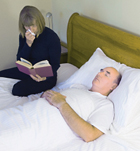
Federal officials plan to spend more time this year examining how hospices market themselves to nursing homes, according to a 2012 work plan released by the Department of Health and Human Services’ Office of Inspector General.
It’s not difficult to see why the government is taking notice. Once a little-known component of the healthcare sector, hospice care has blossomed into a $14 billion industry. But some critics are taking issue with the way such growth has been achieved.
In a recent report, Bloomberg noted that hospice “has become a growth industry, with $14 billion in revenues, 1,800 for-profit providers and a base of Medicare-covered patients that doubled to 1.1 million from 2000 to 2009.”
The Bloomberg article examines the plight of Janet Stubbs, who “didn’t know that her aunt, Doris Midge Appling, was admitted to Hospice Care of Kansas during the company’s ‘Summer Sizzle’ promotion drive, which paid employees as much as $100 a head for referrals.”
For many who have experienced hospice as it was intended — palliative and comfort care for near-death patients and their families — it is shocking to learn that hospice care is promoted like the sale of used cars or mattresses.
Based on an extensive examination of court documents, Bloomberg reported that the incentives for false certification of terminal illness are apparently huge, including compensation based on enrollment numbers, pay to nursing home doctors who double as hospice medical directors, and gifts to the nursing facilities.
At least seven lawsuits allege that incentives spurred hospices to admit patients who weren’t dying.
The Medicare Payment Advisory Commission (MedPAC) had also found hospices “aggressively marketed” to nursing home residents, and paid incentives to medical directors for “inappropriate” referrals and enrollments.
From the February 01, 2012 Issue of McKnight's Long-Term Care News




